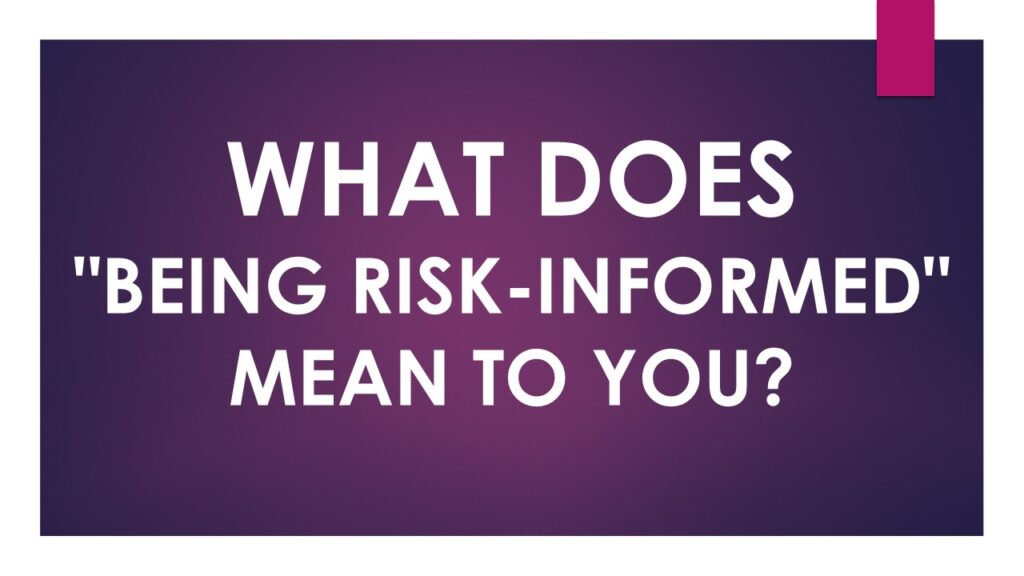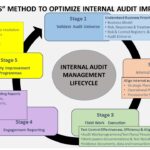AI can help you, but you need to be knowledgeable to savour the benefits.
Being risk-informed is a popular phrase in our everyday life – at corporate, personal, social, religious and family levels.
Entrepreneurs /equity investors build businesses to leave legacies that survive beyond them. Taking the right decisions and actions timely based on being risk-informed guarantees that the legacies can stand test of time.
Risk could be negative or positive. Negative risks are injurious because they prevent or limit the achievement of success, growth and longevity while positive risks facilitate the achievements. Taking decisions and making choice of action are part of taking risks and we do this in our everyday life either intentionally or otherwise.
Good knowledge of all the relevant information including the risk exposures around the subject of interest for which we want to take decisions and choice of actions will certainly help in taking effective decisions and actions to achieving the targeted goals. Some of the key information that are mandatory to be known about specific risk exposures include the following:
- risk source,
- risk nature and type,
- risk indicators or triggers,
- risk sizes (inherent and residual)
- risk consequences and impacts,
- risk appetite and tolerance levels (acceptable risk limits at aggregate and unit levels)
- risk likelihood of occurrence (frequency of occurrence) and
- risk velocity (speed of occurrence).
Making sound judgement requires collecting specific information about each risk element of the on each of the risk elements when taking decisions is important and requires collecting specific information about the subject matter that is exposed to risks.
What does “Being Risk-Informed” Mean To You?
For me, “being risk-informed” means
- Don’t wait to fail before you start to plan.
- Get all the relevant information that are required to take proper decisions and actions timely.
- Take decisions and actions strictly based on accurate, complete and relevant information.
- Build confidence, trust and resilience to drive success, growth and longevity in calm, stormy and turbulent waters.
Achieving the above means understanding the right process to follow and adhering to the process rules and activity steps.
Examples Using Land Asset Acquisition to demonstrate the importance of being risk informed.
Land asset acquisition may be outright buying or leasing.
Land acquisition cuts across all entities – personal, corporate, social groups and religious bodies. Owning land assets could be rewarding because most of the time the value appreciates over time, however, the acquisition could be very exhausting economically and emotionally because of the dramas and negative risk levels involved.
Many have continued to take healthy advantage of the positive risks around land acquisition and made huge progress. Sadly, many others have continued to fall victims causing setbacks – financial losses, reputational damage and legal entanglements resulting in psychological and mental exhaustion, simply because they have taken hasty and blind decisions without proper attention to the negative risks associated with the transactions.
A land asset owner who unknowingly engages the services of an agent that lacks integrity to help in the land asset sale will certainly meet with bitter experience. The same applies to a credible agent acting on behalf of a land asset owner that lacks credibility and integrity.
Similarly, any prospective land asset buyer who takes decisions and actions to pay for a land asset without having knowledge of all the relevant information exposing the associated risks will certainly have some regrets. The risk exposures for acquiring land assets in remote and traditional villages appear to be less than acquiring land in metropolitan cities. The reason is that in traditional villages land is generally owned by ancestral families and the true history of land ownerships remain with the elders in the villages and passed from one generation to another. In this case, land transactions are generally regulated by the customs and tradition of the villagers which may not require documentations of ownership title documents.
In contrast, land transactions in metropolitan cities are regulated by government (federal, state, local government and agencies) and proof of land ownership is through issuance of relevant title documents to the actual landowner by the applicable government arm. This is because metropolitan cities have people from different locations, culture and race with no history linked to the ancestral land.
The key risks that are linked to the prospective land buyers in metropolitan cities and other locations where land transactions are regulated by government are numerous, but the most common ones are as stated below:
| Key Areas of focus | Examples of specific negative risks |
| 1) Complex stakeholders’ interests and roles issues | Subject to the jurisdiction, there may be to many numbers of stakeholder levels involved in concluding land transactions, thus resulting to significant time delay and excessive costs arising from multiple documentations and fee charges. Examples include where the buyer is required to pay different fee charges to federal, state, local government, traditional rulers, community leaders, residents and families. |
| 2) Genuineness of land ownership title documents issues. | Illegal land title documents – fake or forged. |
| 3) Authenticity of land owner (s) issues. Multiple owners particularly those passed by inheritance or jointly procured by two or more parties | (a) Illegal landowners – fake owner(s), land grabbers, (b) Incomplete involvement or lack of consent of all joint owners of the land. |
| 4) Authenticity of seller(s) or agent(s) or developers issues. | (a) Unauthorized agents or developers – fake agents or developers. (b) Real authorized agents/developers but lacks credibility and integrity. |
| 5) Completeness of land ownership titles issues. | Incomplete documents and poor documentations. Example CofO exists but Deeds of Assignment or Land Survey documents missing or not yet processed. Getting them processed in order to complete the land purchase deal may mean that the prospective buyer may have to process the document(s) with own money and this will certainly cause delay and cost increase of land. In this circumstance, such expenses should be deducted from the total sales cost of the land asset by the buyer. |
| 6) Total Ownership costs issues. | The small prints or hidden charges not disclosed early in the transaction but disclosed by the landowner or agent towards the end of concluding the transaction, particularly when the buyer has demonstrated strong interest and readiness to pay for the land. This act could be very frustrating leaving the buyer with a little window to think with limited choice to back out of the transaction. |
| 7) Length of ownership rights issues. | Very short land tenure, not giving sufficient time to earn the full rewards of the land by the buyer. |
| 8) Land injunction issues. | Disputes – litigations, petitions, Communal class. |
| 9) Land status issues. | (a) Government revocation, (b) Multiple allocation to different people, (b) Sold many times to different people, (c) Public reserved area, (d) Government reserved area and (d) Family or community deity. |
| 10) Ecological or environmental issues. | (a) Prone to natural calamity – flood, erosion, bushfire, (b) Lack of government support for compensations to victims. |
| 11) Rules governing land transactions. Statutes/laws, regulations, standards, traditions and customs of the land. | (a) Ambiguous rules, (b) Stifling rules, (c) Rapid changes, (d) Inconsistent applications or enforcement by the authorities. |
| 12) Professional Service Providers. | Engagement of a third-party service provider with: (a) lack credibility – knowledge, experience and experience on land matters. (b) No integrity – lacks honesty and respect, does not adopt fairness, firmness and consistency in treatment of issues |
The key questions the prospective land buyer need to ask and seek answers to:
- What are the likelihood of the prospective buyer encountering the above issues?
- What are the potential impacts – how much loss (money, reputation, emotional and mental health, etc.) can be experienced?
- Are there things that the buyer can do to prevent or minimize the risk likelihood and impacts?
To effectively respond to the above questions requires that the prospective land buyer must obtain all the relevant information relating to the and objectively analyze the findings before taking decisions and actions. Ignoring this is at the buyer’s peril.
So, what type of information should the prospective land buyer gather, analyze and use to support effective decisions and best choice of actions ensuring significantly mitigation of the risk exposures?
Applying proper due diligence or risk assessment processes in gathering the relevant information, analyzing and interpreting the findings and drawing objective conclusions to guide decisions and actions is critical. However, this could be challenging, time consuming and expensive.
The prospective buyer may consider using the services of credible independent professionals with credibility and integrity in order to mitigate the risk exposures inherent in most land transactions. This requires that the buyer must exercise extreme patience allowing the professional service provider to follow appropriate processes and rules to complete the job. Credibility here means having the right knowledge, skills and experience on land transactions and matters. Integrity means “being firm, honest, fair, respectful and consistent handling issues”.
| Presented below are some of the relevant and critical information that the prospective land buyer requires to gather, analyze, interpret and leverage the findings to make appropriate decisions and actions towards land acquisitions. |
| 1) Obtain information about all the legal documents and types required to process land ownership title documents in the jurisdiction or locality, authorized issuers of the title documents, standard processing timeline, associated fee charges and complaints resolution steps Examples of such documents include: (a) Certificate of Occupancy (CofO), (b) Deed of Assignment, (c) Letter of Administration (Governor’s Consent), (d) Land survey document. (e) Physical developments (constructions) and planning approval permits, (f) Other documents that grant legitimate right to land ownership or occupancy |
| 2) Obtain information about the key stakeholders involved in the land acquisitions, their interests and roles, boundaries and interfaces. Examples: (a) government (federal, state, council or local government), (b) traditional rulers, (c) community leaders (e) Families, (f) resident associations and (g) influential individuals. Never take the voice of any of the stakeholders for granted because a strong petition from the residents or an influential person in the environment can cause unexpected hurt. |
| 3) Obtain information about the rules governing land acquisition in the jurisdiction. These include statutes/laws, regulations, standards, written and unwritten traditions and customs prevalent in the jurisdiction or locality. |
| 4) Obtain information about government approved activities for the area for example areas marked for residential, commercial, public or government reserved and the nature and types of structures that can be constructed in the area. |
| 5) Obtain information about the status of the social infrastructure in the area. Check for availability, accessibility and affordability, terms and conditions to get one done where none exists or what exists is not functional.. |
| 6) Obtain information about the trends (negative and positive) prevalent in the area for example physical security, support groups, etc. |
| 7) Obtain information about “Status of Limitation” for seeking redress for breach of contract by the land owner or prospective land owner (seller) |
| 8) Obtain information about the following (a) Genuineness of the land owner(s) and the williness to sell the land. (b) Authenticity of agents selling on behalf of the land owner. Check If the agent is authorized by the real land other for the sale (c) Authenticity of the land ownership title documents. (d) Authenticity of the document issuers. Check if the issuer of the title document is truly authorized by the right authority to issue such documents.. Some of the key documents required for proof of land ownership title which must be checked for the real owners and authenticity of the issuing authorities include the following: (a) Certificate of Occupancy (CofO), (b) Deed of Assignment, (c) Letter of Administration (Governor’s Consent), (d) Physical developments (construction) and planning approval permits, (e) Land survey document. Check that the survey coordinates truly relate to the land and that the names on the document match letter to letter with the CofO and all other related documents that grant legitimate right to the land ownership and occupancy. (f) Other documents required. (g) Check that description of the names on all the documents match letter to letter. |
| 9) Obtain information about any past, current and pending disputes on the land such as (a) Litigations, (b) Petitions, (b) Complaints, (c) Challenges and (d) Injunctions. |
| 10) Obtain information about the tenure or length of land ownership rights authorized by law on the land asset. In some jurisdictions, land ownership tenure could be 99 years, less or more |
| 11) Obtain information about the age of the current ownership titles on the land and number of years remaining to hit the government approved tenure of length of ownership right on the land. |
| 12) Obtain information about the total ownership cost of the land asset including known and hidden charges. |
| 13) Obtain information about the reimbursable deductible by the prospective buyer from the land gross sells value. Reimbursable costs are potential cost that the buyer bears directly for processing other ownership title documents missing or not completed by the real owner of the land selling. This cost should be deducted from the amount to payable to the seller. |
| 14) Obtain information about hidden terms and conditions that may come up just immediately after the buyer has made payment or just about the time the agreement is to be signed by both parties. This instance happens when the land owner or authorized agent wants to extort or take undue advantage of the buyer for selfish purposes. The buyer must ensure that the (a) contract document does not contain any ambiguity (b) terms and conditions of the contract are signed both parties before parting with payment to the land owner/authorized seller (agent) (c) “Status of Limitation” is well understood by all the parties and included in the contract agreement and also enforced promptly. |
It is important to note that the above list is not exhaustive but enough to awaken the prospective buyer’s curiosity, skeptical mindset and critical thinking to constructively engage the parties involved in land transactions including holding meaningful conversations with the professional service providers that the buyer has engaged to help carry out the due diligence or risk assessment on the prospective land asset.
Presented below are the benefits derivable by the buyer engaging the services of a professional service provider with credibility and integrity as well as the buyer exercising patience to allow the job completed in the right way.:
confidence to:
- quickly spot early warning signs or red flags of the dangers ahead,
- form objective opinion about the risk exposures on the asset and justifications.
- take appropriate decisions and actions and
- clarity and vsibility of the total ownership costs and
- defend decisions and actions and justifications.
Conclusion.
Being risk informed and application of the risk information in taking decisions and actions is a necessity for driving success, growth and longevity in every aspect of our endeavors. And this requires haing the right knowlege, skills and experience and healthy collaborations and partnerships with others.
Thank you for investing your valuable time to read my thoughts.
Please, leave a comment to help me get better.
For more other writings, check >>>>> https://sallyogwookeyumahi.com/
#realestate #Landtransactions #landbuying #risk #informeddecisions#riskbased.


